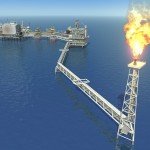 West Texas Intermediate and Brent crude fell for a second day as oil prices failed to find a stable floor before OPEC members convene next week to discuss the group’s production policy, while Iran met with world powers in Vienna for talks over the Islamic Republics nuclear program. Natural gas retreated after its biggest daily advance in nine months.
West Texas Intermediate and Brent crude fell for a second day as oil prices failed to find a stable floor before OPEC members convene next week to discuss the group’s production policy, while Iran met with world powers in Vienna for talks over the Islamic Republics nuclear program. Natural gas retreated after its biggest daily advance in nine months.
January US crude fell 0.45% to $75.32 per barrel by 13:46 GMT on the New York Mercantile Exchange, having shifted in a daily range of $76.48-$75.20. The contract slid 0.21% to $75.66 on Monday.
Meanwhile on the ICE, Brent for settlement in the same month slid 0.86% to $78.63 a barrel. Prices ranged between day’s high and low of $79.95 and $78.60 a barrel, respectively. The European benchmark crude fell 0.13% to $79.31 a barrel yesterday. Brent was at a premium of $3.31 to its US counterpart, down from Monday’s close at $3.65.
Venezuela, one of the OPEC members which have been calling for an extraordinary group meeting to address the recent oil price rout, met with Russia to discuss ways to support the market. Venezuela’s Foreign Minister Rafael Ramirez examined with Russian Energy Minister Alexander Novak on Monday “the need to coordinate actions in defense of oil prices”.
Meanwhile, the head of Russian state-owned oil giant Rosneft, Igor Sechin, is expected to attend OPEC’s November 27 meeting, with officials saying that he would fly to Vienna two days earlier.
Venezuelan President Nicolas Maduro said on Monday that a special global meeting is being planned “very soon”, while Iranian Oil Minister Bijan Namdar Zanganeh is scheduled to visit the United Arab Emirates this week.
However, despite the pickup in diplomatic activity, investors broadly assumed that OPEC is unlikely to slash its production target next week, leaving the market without a significant floor.
Goldman Sachs analysts said that although the current bearish conditions raise the likelihood of a production cut, trimming output by more than 500 000 bpd would require by OPEC further reductions in 2016 and beyond. This in turn would allow US shale producers to gain market share, the investment bank said.
Meanwhile, talks in Vienna resumed today between Iran and the US, UK, Russia, Germany and France to try reach an agreement on curbing the Persian Gulf nations nuclear program in exchange for lifting tough economic sanctions that have battered its economy.
Bloomberg cited US officials, who said, under conditions of anonymity, that gaps between the two sides still persist, despite the progress that was achieved at last weeks meeting between US Secretary of State John Kerry and Iranian Foreign Minister Mohammad Javad Zarif in Oman. One of the US officials said an accord might be reached on November 24th but at the cost of tough decisions by Iranian leaders.
Economic data, US supplies
The oil market drew some support by a weaker dollar today and as investor sentiment in Europe improved in November. Also on the positive side, consumer prices in the UK accelerated last month, while producer inflation in the US raced ahead of expectations as companies received higher prices for new model cars, electric power, pharmaceuticals, beef and pork.
However, the latest sign of economic slowdown in China, the worlds second-biggest oil consumer, spurred worries for global demand. China’s National Bureau of Statistics reported that house prices slid for a second month in October, by an annualized 2.6%, underscoring a persisting property sector downturn.
Some support might be drawn by this week’s US supply data, with analysts’ estimates pointing to a 1-1.2-million-barrel decline in US crude oil inventories in the seven days ended November 14th. An even closer attention will be paid to the pace of US crude oil production, which reached a record level in the preceding week.
However, readings largely in line with projections are expected to be overshadowed by any news of diplomatic activity within the Organization of the Petroleum Exporting Countries.
Industry group the American Petroleum Institute will release its separate inventory report at 21:30 GMT today.
Natural gas
Natural gas retreated after posting its biggest daily advance since February 19th as weather forecasts called for Arctic temperatures across major US consuming areas this week, with another cold pattern set to unfold in the beginning of December.
Natural gas for delivery in December traded at $4.262 per million British thermal units at 13:54 GMT, down 1.82% on the day. Prices ranged between $4.327 and $4.236. The contract surged 7.99% on Monday to $4.341, having hit a one-week intraday high of $4.347 per mBtu.
According to NatGasWeather.com, natural gas demand in the US will be high compared to normal in the next seven days, with a neutral weather trend for the November 25 – December 1 span.
The central and eastern US will be dominated by Arctic conditions today, with readings plunging 18-30 degrees Fahrenheit below normal. The Midwest and Northeast will see temperatures drop into the lower teens, inducing very high early season heating demand. Moreover, the cold wave will also extend deep into the Southeast during the next few days but temperatures over Texas and the Plains will begin to gradually warm up today.
The Arctic readings will loosen their grip at the end of the week and give way to milder conditions as a Pacific jet stream enters into the western US on Friday, NatGasWeather.com reported, allowing for mostly seasonal temperatures to return across most of the US during the weekend.
Next week, the western US will continue to enjoy seasonal or slightly higher readings. However, the central and eastern US will see a large number of weather systems with rain and snow that will lead to below-average temperatures between November 27th and December 1st, including over the Southeast.
Supplies
The Energy Information Administration reported on Friday that US natural gas inventories rose by 40 billion cubic feet (bcf) in the seven days ended November 7th. Total gas held in US storage stood at 3.611 trillion cubic feet, narrowing its deficit to the five-year average of 3.848 trillion to 6.2%. Inventories were 5.7% lower compared to last year’s 3.831 trillion cubic feet during the comparable period.
Due to last week’s much colder than usual weather, this Thursday’s EIA report is expected to show the first weekly withdrawal since the beginning of the replenishment season in April. Analysts’ early estimates ranged between a draw of 6 to 18 billion cubic feet, compared to the five-year average decline of 10 bcf.
Moreover, this week’s impressive Arctic blast is projected to lead to a significant draw for next week’s report. Tim Evans, an energy analyst at Citi Futures, said, cited by Bloomberg, that he expects the November 27th report to show a 130-bcf decline in US natural gas stockpiles.





